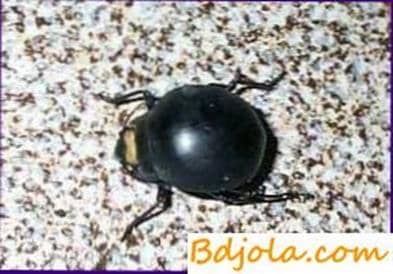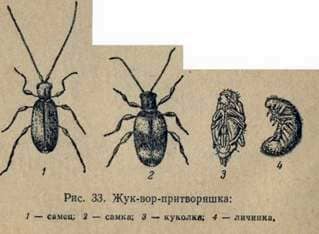
The thief – the pretender is related to the genus Ptinus, meets up to 20 species. The most common in the hives are Ptinus fur L. and Ptinus raptor Str.
 The Ptinus fur beetle is 4 mm long, 1.5 times wide male, 2.5 mm female.
The Ptinus fur beetle is 4 mm long, 1.5 times wide male, 2.5 mm female.
The male is cylindrical, the female is oval in shape, almost twice as wide as the male. The head and antennae of the beetle are yellow.
Elytra dark or reddish-brown, with transverse point hairs arranged in rows and forming two whitish spots on the elytra. Development from the egg to the adult form lasts under favorable conditions for 100 days.
Adult larvae 4 mm long, white, covered with dense yellowish hairs, giving a cream color, yellowish-white head. Larvae-polyphages feed on warming materials: paper and woolen fabrics, felt, leaves, etc., as well as pergolas, honeycombs and wooden parts of the hive. Pupation occurs in cocoons, which they prepare from feed materials. In a year gives up to three generations.
Prevention and control measures. The maintenance of strong families, providing them with food and warming. The heating material is systematically dried in the sun. The hives are kept clean. Warehouses with honeycombs are ventilated.
Рамки с молью. Ледник для продуктов.
Pests of bees